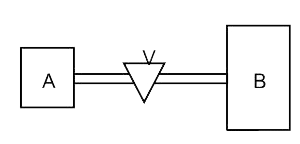If an ideal gas at 100 K is heated to 109 K in a rigid container, the pressure increases by X%. What is the value of X?
The correct Answer is:9
To solve the problem, we will use the relationship between pressure and temperature for an ideal gas in a rigid container. Here’s the step-by-step solution:
Step 1: Understand the relationship between pressure and temperature
In a rigid container, the volume of the gas remains constant. According to Gay-Lussac's law, the pressure of an ideal gas is directly proportional to its absolute temperature when the volume is constant. This can be expressed as:
P∝T
or
P2P1=T2T1
Step 2: Identify the initial and final temperatures
From the problem, we have:
- Initial temperature T1=100K
- Final temperature T2=109K
Step 3: Set up the equation for pressure
Let the initial pressure be P1=P. We need to find the final pressure P2. Using the proportionality:
P2P=T2T1
Substituting the values:
P2P=109K100K
Step 4: Solve for P2
Cross-multiplying gives:
P2=P×109100=1.09P
Step 5: Calculate the change in pressure
The change in pressure ΔP can be calculated as:
ΔP=P2−P1=1.09P−P=0.09P
Step 6: Calculate the percentage increase in pressure
The percentage increase in pressure X is given by:
X=(ΔPP1)×100
Substituting the values:
X=(0.09PP)×100
Step 7: Simplify the expression
The P cancels out:
X=0.09×100=9
Final Answer
Thus, the value of X is:
9%
---
In a rigid container, the volume of the gas remains constant. According to Gay-Lussac's law, the pressure of an ideal gas is directly proportional to its absolute temperature when the volume is constant. This can be expressed as:
P∝T
or
P2P1=T2T1
From the problem, we have:
- Initial temperature T1=100K
- Final temperature T2=109K
Let the initial pressure be P1=P. We need to find the final pressure P2. Using the proportionality:
P2P=T2T1
P2P=109K100K
Cross-multiplying gives:
P2=P×109100=1.09P
The change in pressure ΔP can be calculated as:
ΔP=P2−P1=1.09P−P=0.09P
The percentage increase in pressure X is given by:
X=(ΔPP1)×100
Substituting the values:
X=(0.09PP)×100
The P cancels out:
X=0.09×100=9
Thus, the value of X is:
9%
Topper's Solved these Questions
- BOOK - NARENDRA AWASTHI ENGLISHCHAPTER - GASEOUS STATEEXERCISE - Assertion-ReasonType Questions16videos
GASEOUS STATE
- BOOK - NARENDRA AWASTHI ENGLISHCHAPTER - ELECTROCHEMISTRYEXERCISE - Subjective problems14videos
ELECTROCHEMISTRY
- BOOK - NARENDRA AWASTHI ENGLISHCHAPTER - IONIC EEQUILIBRIUMEXERCISE - Subjective problems1videos
IONIC EEQUILIBRIUM
Similar Questions
If an ideal gas is heated at constant pressure :
View SolutionIf the temperature of an ideal gas in a sealed, rigid container is increased to 1.5 times the initial value (in K), the density of gas
View SolutionWork done in expansion of an ideal gas from 4 litre to 6 litre against a constant external pressure of 2.1atm was used to heat up 1 mole of water at 293K. If specific heat of water is 4.2Jg−1K−1, what is the final temperature of water?
View Solutionpure nitrosyl chloride (NOCl) gas was heated to 240∘C in a 1.0 L container. At equilibrium the total pressure was 1.0 atm and the NOCl pressure was 0.64 atm . What would be the value of KP ?
View SolutionAn ideal gas on heating from 100 K to 109 K shows an increase by a% in its volume at constant P. The value of a is _____________.
View SolutionA sealed container with gas at 2.00 atm is heated from 20.0 K to 40.0 K. The new pressure is:
View SolutionContainer A holds an ideal gas at a pressure 1×105 Pa and at 300 K. Container B whose volume is 4 times the volume of A has the same ideal gas at 400 K and at a pressure of 5×105

Before the valve V is opened, the ratio of number of moles of gas in A and B is :View SolutionA sample of ideal gas (γ=1.4) is heated at constant pressure. If an amount of 100 J heat is supplied to the gas, the work done by the gas is
View SolutionContainer A holds an ideal gas at a pressure 1×105 Pa and at 300 K. Container B whose volume is 4 times the volume of A has the same ideal gas at 400 K and at a pressure of 5×105

The valve V is adjusted to allow the pressure to equalize, but the temperature of each container is kept constant at the initial value, then the pressure in the two containers is :View SolutionAn ideal gas of one mole is kept in a rigid container of negligible heat capacity. If 25J of heat is supplied the gas temperature raises by 2∘C. Then the gas may be
View Solution

